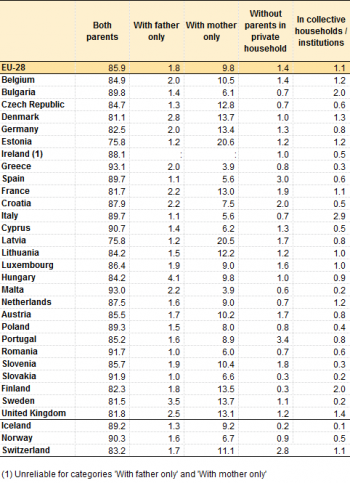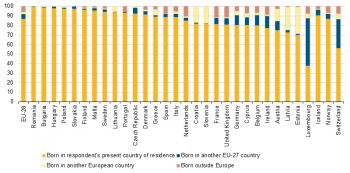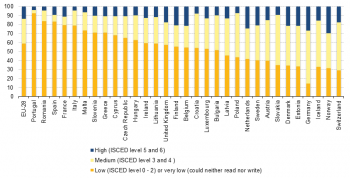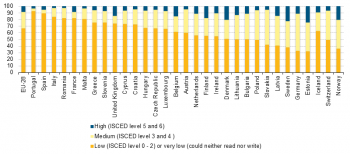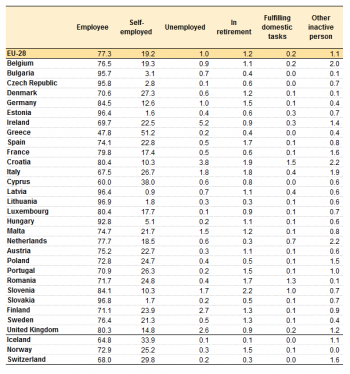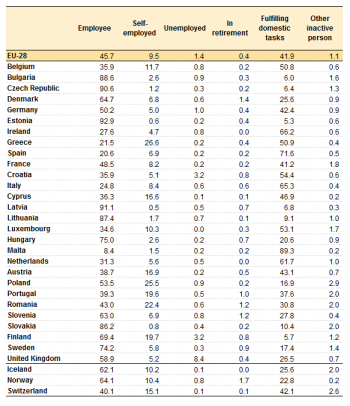Archive:Living condition statistics - family situation of today's adults as children
- Data from October 2013. Most recent data: Further Eurostat information, Main tables and Database.
The findings of this article are based on data from the EU statistics on income and living conditions (EU-SILC) 2011 module on ‘Intergenerational transmission of disadvantages’. Each current household member currently aged 25 to 59 was asked personal questions about their family situation when being at the age of 14. The information on parental socio-economic status and educational background was also collected.
Main statistical findings
Presence of parents in the household
In 2011, 85.9 % of the EU-28 population reported that they lived with both parents (or with persons considered as parents) when they were around the age of 14 years old (Table 1). This rate ranged from 75.8 % in Estonia and Latvia to 93.1 % in Greece and 93.0 % in Malta.
On the other side, at EU level, 11.6 % of the population reported to have lived at the age of 14 in a single-parent household. Almost one tenth of the respondents (9.8 %) lived with their mother only, while 1.8 % lived with their father. Across countries, the share of population living with their mother only was the highest in Estonia and Latvia (20.6 % and 20.5 % respectively). At the other extreme, just 1.8 % of the population lived in the household only with their mother in Ireland. Low percentages were also reported by Greece and Malta (both 3.8 %). On the other side, the rates for Europeans that lived only with their father did not exceed 3.0 % in all countries with the exception of Ireland (8.6 %), Hungary (4.1 %) and Sweden (3.5 %). It should be noted, however, that in case of Ireland, it is likely that the answers “lived with mother only” and “lived with father only” were reversed.
The picture for those who lived in households as young teenagers without their parents is similar across the EU Member States without significantly wide differences. On average, less than 1.4 % of the EU-28 population reported to have lived when 14 in a household without their parents; with the highest shares being recorded in Spain and Portugal (3.0 % and 3.4 % respectively).
Finally, the lowest percentages in all but six countries (Bulgaria, Denmark, Italy, the Netherlands, Finland and the United Kingdom) were reported for those persons that lived in collective households or institutions.
Parents’ country of birth
Figures 1 and 2 present the distribution of the EU-28 population by father’s (or mother’s) country of birth. The country of birth of the father (or mother) is defined as the country of residence of the father's (or mother’s) mother at the time of their birth.
Overall, the percentage of the population living in an EU Member State while their father was born in the same country as their present country of residence (i.e. the country of the survey) accounted for 86.5 %. With the exception of Luxembourg (39.1 %) the rates ranged from 70.6 % in Estonia and Latvia to 99.7 % in Romania and 99.2 % in Bulgaria. The rates exceeded 80.0 % in nineteen Member States while high rates were also reported by Iceland (91.8 %) and Norway (89.0 %).
On the other side, just 5.1 % of the EU population had a father who was born in a different EU Member State. It should be noted that the modality “Born in another EU country” covers 27 Member States since Croatia was not a EU member at the time the data collection took place. Only in Luxembourg did parents born in other EU Member States (48.4 %) outnumbered those born in the present country of residence. In all but eight countries, namely Poland, Lithuania, Greece, Croatia, Slovenia, Austria, Estonia and Latvia, the rates recorded for the population that had a father born in another (other than EU-27) European country were higher than the respective percentages for those born in another EU Member State. By contrast, in the Netherlands, Ireland, Luxembourg, Spain, Belgium and Cyprus the percentage of the population with a father with a non European background was higher than 7.0 %, reaching 12.3 % in the United Kingdom and 12.1 % in France. Switzerland has also reported a high rate (7.7 %).
As regards the country of birth of the mother, the picture is the same in most of the countries. On average, the rate for the EU-28 population having a mother whose country of birth was the same with their present country of residence accounted for 86.9 %, which is somewhat larger to that of the father’s. Luxembourg is again ranked first highest, the proportion of the population whose mother had been born in another EU Member State representing 49.9 % of its total population.
Parents’ Level of Education
The educational level of parents is a key factor affecting the future socio-economic situation of their children. In Europe, more than half of the adults were raised with a father or mother having fulfilled at most lower secondary education. Figures 3 and 4 present the proportion of the population, whose father’s or mother’s highest level of education attainment was high (first stage of tertiary education and second stage of tertiary education), medium (upper secondary education and post-secondary non-tertiary education) or low (pre-primary, primary or lower secondary education) and very low (could not read nor write in any language).
Indeed, the statistics show that on average the percentages of the population with a father or mother with low educational attainment are much higher than for those with a father or mother at higher levels of education. More specifically, for 59.1 % of the EU-28 population their father had not attained upper secondary education, when they were 14. This percentage is by 7.8 pp higher for those having a mother who had achieved only low or very low education. At the other side of the spectrum, Europeans who had a father having achieved high educational attainment accounted for 13.3 % while the respective percentage for those with a mother with high education did not exceed 8.4 %.
However, variations across the EU are considerable for both father’s and mother’s educational attainment. In 2011 the proportion of population having lived with a low skilled father ranged from 92.6 % in Portugal, followed by Romania (84.2 %) and Spain (83.6 %), to 15.0 % in Germany. By contrast, in seven countries, namely Germany (26.4 %), the Netherlands (24.3 %), Estonia (21.5 %), Belgium (21.4 %), Denmark (21.4 %), Sweden (20.9 %) and Finland (20.6 %), one fifth or more of the population had a father with high educational attainment. Switzerland also recorded a high rate which was equal, at 17.3 %, to the rate recorded in the United Kingdom. The highest rate however was found in Norway (29.3 %).
The education profile of mothers does not differ significantly. Fewer than one in ten of Europeans (8.4 %) had a mother with high level of education, and only one in four (24.8 %) of them had a mother who had reached upper secondary education. While in some Southern countries (Portugal, Spain, Italy) high percentages of low educated mothers were recorded, in some Nordic countries (Sweden and Norway) as well as in Germany and Estonia less than 40.0 % of the population had a low skilled mother.
The largest differences, when comparing the population with a high educated father with those that lived in households with a high educated mother, were reported in Germany (15.5 %), the Netherlands (13.1 %), Austria (10.1 %), as well as Switzerland (10.7 %). Finally, in five countries (Lithuania, Latvia, Bulgaria, Sweden and Estonia) the rates for the population whose mother had attained high education are higher than that of the father’s.
Parents’ activity status
The activity status of the parents affects significantly the conditions, in which teenagers live and develop. In the EU, rates for the population with a father in employment (either employee or self-employed) exceeded 96.0 %. As shown in Table 2 this percentage was greater than 90.0 % in all countries.
In detail, figures on the activity status of the father reveal that the majority of the population had a father who was employee, with by far the highest percentages recorded in Lithuania (96.9 %) and Slovakia (96.8 %), followed by Estonia, Latvia (both 96.4 %), Czech Republic (95.8 %), Bulgaria (95.7 %) and Hungary (92.8 %). With regard to the population with a self-employed father, the percentages did not exceed 30.0 % in all countries except for Cyprus (38.0 %) and Ireland (33.9 %). In Greece, especially, the percentage of population having a self-employed father reached 51.2 %, which was slightly higher than that for those with an employed father (47.8 %).
By contrast, the percentages of the population that, as teenagers, lived in a household, where father’s activity status was described as “unemployed” or “in retirement” or “fulfilling domestic tasks”, were considerably smaller, reaching at most around 5.0 % in all countries.
On the other side, the activity status of the mother is almost equally split between employment and engagement on home duties (Table 3). In 14 EU countries as well as in Iceland and Norway, more than half of the population had a mother who was employee with the highest rates reaching 92.9 % in Estonia, 91.1 % in Latvia and 90.6 % in Czech Republic. The percentage for the population with a mother fulfilling domestic tasks varied across the Member States, from 5.3 % in Estonia and 5.7 % in Finland to at least 50.0 % in Belgium, Greece, Luxembourg ,Croatia, the Netherlands, Italy, Ireland and Spain, peaking at 89.3 % in Malta.
Self-employment of mothers was less frequently recorded in Europe (9.5 %). Exceptions can be found in three countries (namely Greece, Poland and Portugal), where more than one in five EU citizens, as teenagers, had lived in a household with a self-employed mother.
The smaller differences, when comparing the percentages of the population with a farther at work, i.e. either employee or self-employed, with the corresponding ones for the mothers, were recorded in Lithuania (9.6 pp), Bulgaria (7.6 pp), Czech Republic (6.8 pp), Finland (5.9 pp), Latvia (5.7 pp), and Estonia (4.5 pp).
Financial situation of the household
Another determinant factor for young people’s future life is the financial situation of the household. Figures in Table 4 reveal that the population in all countries reported very good, or good, or moderately good household financial situation at a higher frequency than those that reported very bad, or bad, or moderately bad financial situation. In detail, almost 71.0 % of the EU-28 population considered that the financial situation of the household, in which they lived in as teenagers was either very good or good or moderate good, while 29.5 % felt that it was very bad, or bad, or moderately bad. Exceptionally, in Slovenia, the percentage of the population, assessing the financial situation of their household at the age of 14 as very bad, or bad, or moderately bad, was by 9.1 pp higher than the respective percentage for those with a positive assessment. Moreover, variations across countries are observed for all assessment categories concerning the respondents’ feelings about the financial situation of the household in which they lived as teenagers.
More than one fourth of the EU population felt that the financial situation of their household was good. The percentages ranged from 12.6 % in Slovenia to 46.8 % in the Netherlands. Lower percentages were reported in Romania (12.9 %), Portugal (14.3 %) and Italy (18.1 %) while among the top ranked countries were Belgium and Sweden (both 38.8 %). Norway and Switzerland also reported high rates (40.3 % and 39.3 % respectively).
However, in almost most countries, except for Malta, Belgium, Sweden, the Netherlands, Norway and Switzerland the percentage of the population with a moderately good assessment was higher than that for those that assessed the financial situation of their household as good. The percentage of the population that on average assessed the financial situation of their household as moderately good reached 39.9 % with Estonia reporting the highest percentage (51.0 %) and the Netherlands the lowest (28.3 %).
In contrast, the financial situation of the household was assessed as bad by just 8.7 % of the EU population. Estonia reported the lowest rate (5.1 %) followed by Denmark (5.5 %) and Bulgaria (5.7 %). In Norway this rate was also low enough (4.3 %). On the other side, in seven Member States, namely, Portugal (17.1 %), Croatia (16.7 %), Romania (14.7 %), Slovenia (12.3 %), Cyprus (12.0 %), Greece (10.9 %) as well as Austria (10.8 %) the percentages exceeded 10.0 %.
Moreover, 16.9 % of the EU population reported to have experienced moderately bad financial situation at the age of 14. This percentage was by far the highest in Slovenia (33.5 %) followed by Austria (23.3 %) and Hungary (23.2 %). At the other extreme, this percentage did not exceed 10.0 % in Sweden, the Netherlands, Denmark as well as Norway.
Finally, it is noteworthy that the rates for the population, which characterised the financial situation of their household either as very good or very bad, are particularly low with the values not exceeding 15.0 % in all countries.
Data sources and availability
Data in this document were extracted from a special module on ‘Intergenerational transmission of disadvantages’ of the EU statistics on income and living conditions (EU-SILC) survey, which was carried out in 2011. All data are available as Excel files downloadable from the Eurostat website
Context
The objective of the 2011 module on ‘Intergenerational transmission of disadvantages’ is to analyse the evolution of the results on this topic and in continuation of the former (2005) ad-hoc module on the ‘intergenerational transmission of poverty’. The extent to which inequalities persist across generations is considered to play a major role in explaining adult social exclusion. In particular, the parental educational background and or their socio-economic status could influence the poverty risk during adulthood.
Further Eurostat information
Publications
- Income and living conditions in Europe – Statistical books
- The Social Situation in the European Union
- Youth in Europe: A Statistical Portrait
Database
- Ad-hoc modules (Assessment and Data - Excel)
- 2011 module: Intergenerational transmission of disadvantages
Dedicated section
Source data for tables and figures (MS Excel)
Other information
- Regulation 481/2010 of 1 June 2010 concerning Community statistics on income and living conditions (EU-SILC)
